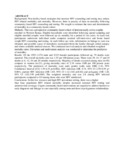Mortality among participants in a communitybased cohort in Western Kenya, findings of the HIV risk and pregnancy incidence study

View/
Date
2015Author
Odoti, A.
Kiarie, J
Kinuthia, J
Farquhar, C
Kurth, A
Nock, C
Irene, I
Peter, C
[et al.]
Type
PresentationLanguage
enMetadata
Show full item recordAbstract
Background: Non-facility based strategies that increase HIV counseling and testing may
reduce HIV related morbidity and mortality. However, there is paucity of data on mortality following
community based HIV counseling and testing. We sought to estimate the rates and
determinants of mortality in a community-based cohort.
Methods: This was a prospective community based cohort of heterosexually active couples
enrolled in Western Kenya. Eligible households were identified following spatial sampling
and eligible enrolled couples were followed up six monthly for a period of two years. At each
visit participants underwent individual audio computer assisted self-interviews and home based
couple HIV counseling and testing. At each follow-up visits, information on linkage to care was
obtained and possible cause of mortalities ascertained from the family through verbal autopsy
and where available medical sources. We conducted survival analysis and obtained weighted
mortality rates. Univariate and multivariate analysis was conducted to determine the predictors
of mortality.
Results: Of the 2593 (1274 male and 1319 female) participants followed up, 79 deaths
were reported. The overall mortality rate was 1.55 per 100 person years. There were 29, 14,
17 and 19 deaths at 6, 12, 18 and 24 months respectively. Majority of deaths occurred among
men (n=58) compare to women (n=21), giving mortality rates of 2.34 versus 0.80 per 100 person
years respectively. The predictors of mortality were male gender (odds ratio [OR] 2.41,
95% Confidence Interval [CI] 1.39-4.19 p=0.002), HIV infection (OR 4.71, 95% CI 2.59-8.59 p<
0.001), partner HIV infection (OR 1.83, 95% CI 1.12-3.02 p=0.02) and polygamy (OR 1.20, 95%
CI 1.02-3.99 p=0.049). The weighted mortality rate was 2.8 among HIV infected participants
compared to 0.9 among those who were HIV uninfected.
Conclusions: In this low resource and high HIV prevalence setting, there was a higher
than base population HIV related mortality despite increased national HIV testing and antiretroviral
coverage. Urgent community based interventions are required to address barriers to early
diagnosis and linkage to care especially among men and those in polygamous relationships.
Publisher
University of Nairobi
